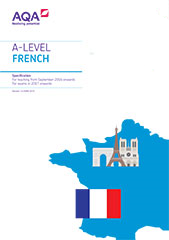3.3 Grammar
AS and A-level students will be expected to have studied the grammatical system and structures of the language during their course. Knowledge of the grammar and structures specified for GCSE is assumed.
In the exam students will be required to use, actively and accurately, grammar and structures appropriate to the tasks set, drawn from the following lists. The mention of an item in these lists implies knowledge of both its forms and its functions at an appropriate level of accuracy and complexity.
The lists are divided into AS and A-level. The examples in italics in parentheses are indicative; they serve to illustrate the part of speech or structure that the student must know and do not represent an exhaustive specification of the required grammatical knowledge. For items marked (R), receptive knowledge only is required.
A-level students will be expected to have studied all grammar and structures that appear in the lists for both AS and A-level.
AS grammar
Nouns
Gender
Singular and plural forms
Articles
Definite, indefinite and partitive
Adjectives
Agreement
Position
Comparative and superlative
Use of adjectives as nouns (eg le vieux, les Anglais)
Demonstrative (ce, cet, cette, ces)
Indefinite (including autre, chaque, même, quelque)
Possessive (mon, ma, mes, etc)
Interrogative and exclamatory (quel, quelle, quels, quelles)
Numerals
Cardinal (eg un, deux)
Ordinal (eg premier, deuxième)
Expression of time and date
Adverbs
Formation of adverbs in -ment
Comparative and superlative
Interrogative (including combien (de), comment, où, pourquoi, quand)
Quantifiers/intensifiers
(including assez, beaucoup, moins, plus, la plupart, plusieurs, presque, tant, très, trop)
Pronouns
Personal: subject, including on
Object: direct and indirect
Disjunctive/emphatic personal, as subject and object: moi/moi-même, etc
Position and order
Reflexive
Relative (including qui, que, dont, lequel etc, auquel etc, ce qui, ce que)
Demonstrative (celui, celle, ceux, celles; and celui-ci/celui-là etc)
Indefinite (including quelqu’un, quelque chose)
Possessive (le mien etc)
Interrogative (including qui, que, quoi)
Use of y, en
Verbs
Conjugation of regular -er, -ir, -re verbs, modal verbs, principal irregular verbs, including reflexive verbs
Agreement of verb and subject
Use of il y a
Modes of address (tu, vous)
Impersonal verbs
Constructions with verbs
Verbs followed by an infinitive (with or without a preposition)
Dependent infinitives (faire réparer) (R)
Perfect infinitive
Negative forms
Interrogative forms
Use of tenses:
- present
- perfect (including agreement of past participle)
- imperfect
- future
- conditional
- future perfect
- conditional perfect
- pluperfect
- past historic (R).
Use of the infinitive, present participle (eg en arrivant) and past participle
Verbal paraphrases and their uses (including aller + infinitive, venir de + infinitive)
Passive voice:
- present tense
- other tenses (R).
Subjunctive mood: present (common uses, for example, after expressions of possibility, necessity, obligation and after conjunctions such as bien que)
Prepositions
All prepositions, both simple (eg sous) and complex (eg au-delà de)
Conjunctions
Coordinating conjunctions (eg et, ou, mais)
Subordinating conjunctions
Negation
Use of negative particles (eg ne...pas, ne...personne, ne...que)
Use of ne with negative subjects (eg Personne n’est venu)
Questions
Commands
Word order
Inversion after speech
Other constructions
Time expressions with depuis and il y a
Comparative constructions
Indirect speech
Discourse markers
(eg Au contraire, En fait)
Fillers
(eg alors, bon)
A-level grammar
In addition to the vocabulary listed in the AS grammar list, students of A-level will also be expected to study the following:
Verbs
Dependent infinitives (faire réparer)
Passive voice: all tenses
Subjunctive mood:
- perfect tense
- imperfect tense (R).
Word order
Inversion after adverbs
